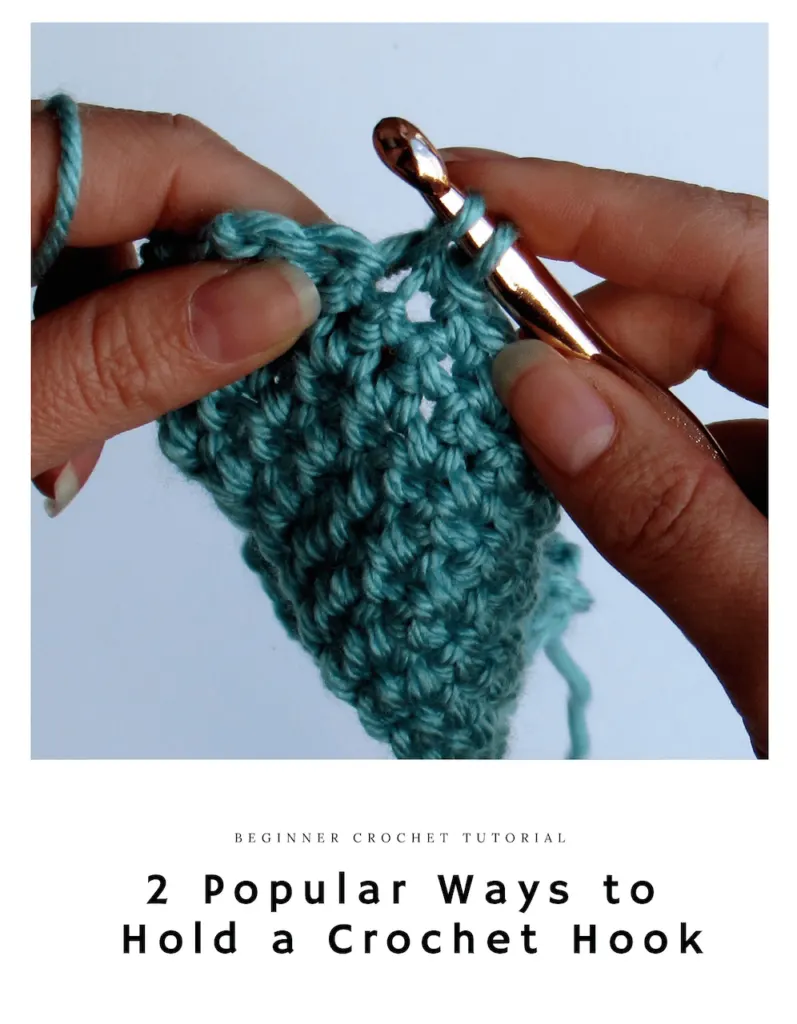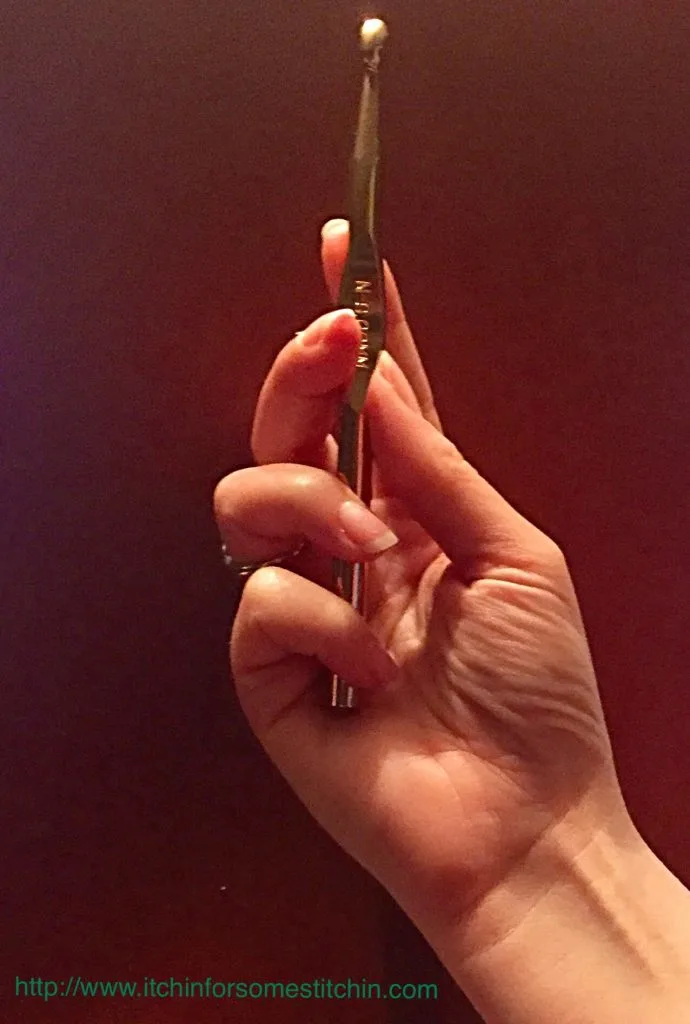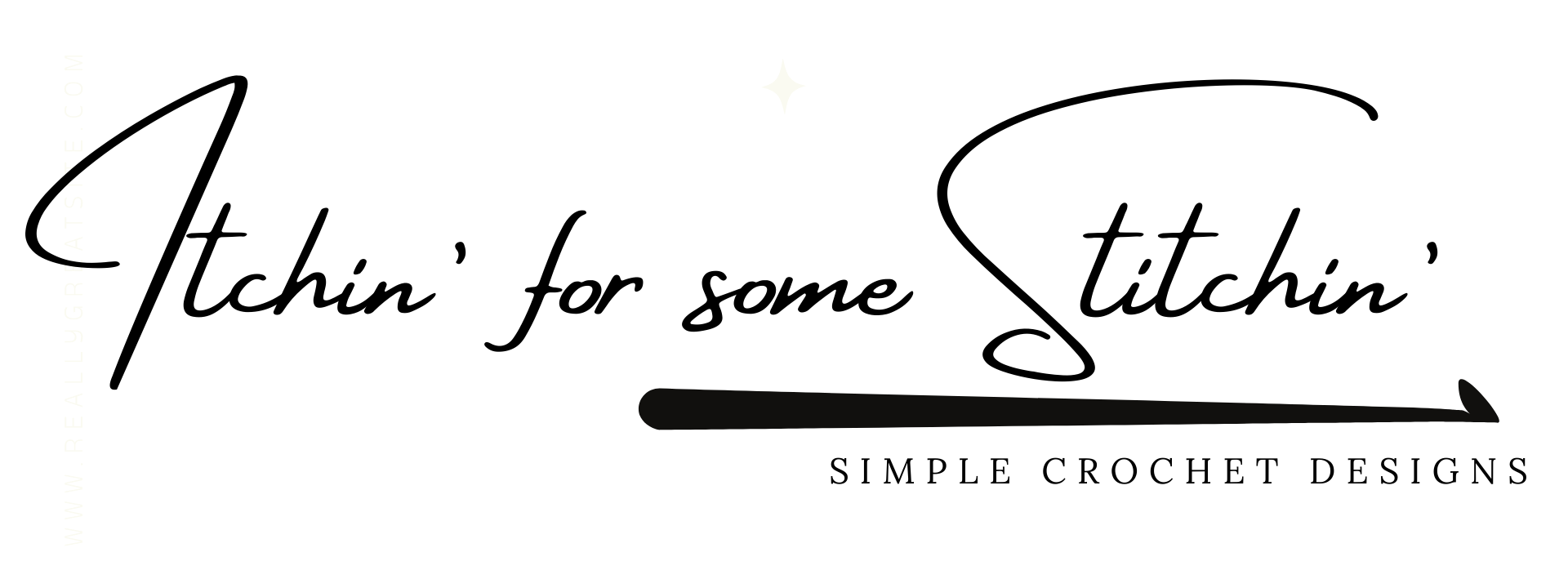
Learning how to hold a crochet hook correctly is an essential skill for any crocheter. The way you hold your crochet hook impacts your tension, stitch quality, and overall comfort while working on your projects. In this post, I will guide you through different crochet hook holds and provide valuable tips to help you find the most suitable grip for your hand and crochet style.
Hi there crochet newbies!
Today I want to go over something you may not think is all that important, but actually is.
It’s how to hold a crochet hook.
Now, for a lot of people, holding a crochet hook while crocheting comes naturally.
Yet, for many others, it does not.
Believe it or not, but I have actually known people who have quit crocheting because they struggled with this very thing!
It can be very frustrating when you can’t seem to hold the hook in a way that works and flows comfortably with the yarn.
For these people, holding a crochet hook can take some practice – and that’s okay!
* This post may have affiliate links. See my full Disclosure Policy for details.
Why Is Learning to Hold a Crochet Hook Important?
You may be asking yourself, is this really a big deal?
Can learning different crochet hook hold techniques really make a difference?
Yes it can!
If you hold the hook in a way that does not work best for you, it can will make your hand uncomfortable while crocheting.
If your hand isn’t comfortable it may cause your stitches to be uneven and make your project look misshapen.
Additionally, your hand could seriously cramp up causing unnecessary pain.
Crocheting should be relaxing not a struggle!
What’s the Best Way to Hold a Crochet Hook?
As an absolute crochet beginner, perhaps someone who has never even picked up a hook before, or simply someone who struggles with using the hook while crocheting, you may be wondering – what’s the best way to hold the hook?
Well, the truth is. The best way to hold a crochet hook is the one that is most natural and comfortable for you.
There is no right or wrong way to hold a crochet hook!
Seriously, if you understand this from the beginning it takes all that – “omg, how do I do this? ” or the “I’m doing this all wrong!” – pressure and fear away from the get go.
You don’t have to hold you hook like that your grandma, your best friend, or that person you saw in the YouTube video.
And you’re not going to do it wrong! Because there is not wrong way!
That being said, there are some common ways that a lot of people do hold their hooks and practicing these methods may give you some guidance while you are determining the way that works best for you.
Quick note:
For those of you who are so new to crochet that you’ve never held a hook or have never crocheted even one stitch before – the crochet hook goes in what’s called your working hand.
This is typically your dominant hand.
Your other hand holds the yarn.
Things to know before you start:
» CLICK HERE TO VIEW THE KNIFE GRIP INSTRUCTIONS
2 Popular Ways to Hold a Crochet Hook
Position One: Knife Grip
Called the over-the-hook position, a.k.a. the knife position or knife grip because and is similar to holding a knife.
Here’s how to do it:
Place your hand over the crochet hook with the handle resting against the palm of your hand and your thumb and third finger grasping the thumb rest.

As you can see, the knife grip is a crochet hook hold that mimics the way you hold a knife while cutting.
It provides a firm grip and is especially useful for crocheters who prefer speed crocheting or working with thicker yarns.
Let’s go over the knife grip again in further detail.
Hand Position:
To review, hold the crochet hook handle between your thumb and middle finger, just like holding a knife. Your index finger should rest lightly on the top of the hook or along the shaft for added control.
Thumb Placement:
Position your thumb along the flat side of the hook, applying gentle pressure to hold it in place. This helps stabilize the hook while allowing for easy movement.
Control and Tension:
The knife grip offers excellent control over the hook, making it easier to maneuver through stitches and maintain consistent tension.
The grip allows for quick and precise movements, which can be advantageous when working on intricate or time-sensitive projects.
Speed Crocheting:
The knife grip is often favored by crocheters who prefer to work at a faster pace.
The ergonomic position of the hand and the efficient movement of the wrist and fingers contribute to increased speed without compromising stitch quality.
Suitable for Thicker Yarns:
The knife grip provides a sturdy hold, making it ideal for crocheting with thicker yarns or projects that require a firmer stitch.
The grip allows for better control and prevents the hook from slipping or twisting within the stitches.
» CLOSE THE KNIFE GRIP INSTRUCTIONS
» CLICK HERE TO VIEW THE PENCIL GRIP INSTRUCTIONS
Position Two: Pencil Grip
Called the under-the-hook position, a.k.a the pencil hold or pencil grip because it is similar to holding a pencil.
Here’s how to do it:
Hold the crochet hook as you would pencil with the thumb rest between your thumb and forefinger. The third finger should be near the tip of the hook.

The pencil grip offers comfort and precision, making it a preferred hold for many crocheters.
Including me!
Let’s go over the pencil grip again in further detail:
Hand Position:
To review, hold the crochet hook as you would hold a pencil, with the handle resting against the pad of your thumb and the shaft resting along the side of your index finger.
Your thumb and middle finger should gently pinch the hook for stability.
Thumb Placement:
Position your thumb along the flat side of the hook, providing support and control.
The thumb helps guide the hook through the stitches while maintaining a consistent tension.
Fingertip Control:
The pencil grip allows for precise control over the hook.
Your index finger acts as a guide, facilitating smooth movements and accurate stitch placement.
This grip is particularly useful when working on intricate stitch patterns or fine details.
Comfortable and Relaxed:
The pencil grip promotes a relaxed hand position, reducing strain and fatigue during long crochet sessions.
The natural alignment of the fingers and wrist helps prevent hand cramping and allows for hours of comfortable crocheting.
Versatile for Different Yarns:
The pencil grip works well for various yarn weights and projects.
It allows for a lighter touch, which is beneficial when working with delicate or lightweight yarns.
However, it may require some adjustment for handling thicker yarns or creating tighter stitches.
Love Pinterest?
I do!
PIN this pattern to your Pinterest boards for later.
You can also follow all my boards!

Remember, the knife hold and the pencil hold are only two of the many ways to hold a crochet hook, and the best grip for you depends on your personal preference and comfort.
I encourage you toeExperiment with different holds to find the one that feels most natural to you.
Choose the one that allows you to crochet with ease, comfort, and enjoyment!
» CLOSE THE PENCIL GRIP INSTRUCTIONS
» CLICK HERE TO VIEW TIPS & FAQS
Tips for Holding a Crochet Hook
- When crocheting, the crochet hook should be turned slightly toward you, not facing up or down.
- The crochet hook should be held firmly, but not tightly.
- At first you will find yourself gripping tightly but over time, once you feel more comfortable, you will find your hand relaxes.
FAQs
Let’s go over some commonly asked questions about how to hold a crochet hook!
Can you use different holds for different crochet projects?
A:Absolutely!
Definitely experiment with different holds to find what works best for you.
Some crocheters prefer the knife grip for larger projects, while others may opt for the pencil grip for intricate stitch work.
And still other crocheters don’t use the pencil hold or knife hold at all.
I know crocheters who hold their hooks like a spoon or even a shovel!
It’s all about finding your comfort and control.
How do I keep my hand from tiring when holding a crochet hook?
The best thing you can do to prevent hand fatigue is take regular breaks.
Stretch and flex your hands and fingers to improve blood circulation.
There are even some exercises you can do to help. I demonstrate some of them in an Instagram Live video a few years ago.
You can check them out the video via the button below.
You can also try using ergonomic crochet hooks or experimenting with different grips to find the most comfortable option for you.
Can I switch my crochet hook hold if I’m not comfortable?
Of course! And you should!
It’s important to find a hold that feels natural and allows you to crochet for extended periods of time without pain or discomfort.
Don’t be afraid to try different holds until you find the one that suits you best!
Did you practice each technique? Which one feels best for you?
It’s totally fine if neither of these methods works for you. As I said, there really is no right or wrong way to hold a crochet hook.
However, experimenting with these two methods can give you a starting point.
You can then make adjustments to find the technique that is right for you.
If you use a different hold or you’ve decided to make of up your own then please share, I’d love to know!
More Crochet Tips & Tutorials
Ready to learn more? Check these out!
1. How to Yarn Over in Crochet
2. How to Read a Crochet Pattern
4. How to Crochet a Foundation Chain
Additionally, you can follow me on Facebook and join my Facebook group for crochet beginners!
I share lots of tips & tutorials to help you along in your crochet journey!
Plus, since it’s open to experienced crocheters too, you can get some really great advice from different perspectives – all the while gaining new friends and crafty inspiration!
Thank you for coming to my blog! By sharing my content and/or making a purchase you are making it possible for me to continue producing and sharing free content for everyone to enjoy. I sincerely appreciate your support!
Until next time… Happy Crocheting!

PLEASE SHARE!
» CLOSE TIPS & FAQS

Linda H
Saturday 28th of November 2020
I'm a very comfortable position one. Thank you for teaching us.
Itchin4Stitchin
Thursday 10th of December 2020
Hi Linda,
Of course! Any time. :)
Sincerely,
RaeLynn
Miss Daisy
Friday 15th of November 2019
I also have joint pain so will try this, thanks. Do you teach knitting ?
Itchin4Stitchin
Thursday 21st of November 2019
Hi Miss Daisy,
I do teach knitting, but in full disclosure I have just recently switch email servers so my knitting welcome series is not fully set up yet.
So if you sign up for the newsletter you'll receive mostly crochet related information for a bit.
Sincerely,
RaeLynn
Jojo Sewist
Monday 27th of August 2018
My MIL who cd crochet a mile a min. held the hook like a small child wd hold a spoon. I use combo of the 2 you showed. I enjoy your posts and look forward to each. Thank you for sharing with us.
Itchin4Stitchin
Thursday 30th of August 2018
Like a spoon? Really? I've not heard that way before. I have had a lot of people come forward to tell me the different ways they hold their hooks. I am thinking of updating this post or creating a new post to share what I have learned. I will do a bit of research on holding it like a spoon and add it. Thank you so much!
Best wishes,
RaeLynn
Lady Lilith
Saturday 4th of June 2016
Looks good. My mother tried to teach me a few years back, but I never cought on.
Itchin4Stitchin
Sunday 5th of June 2016
Well I hope some of the resources on my blog can help you get started!